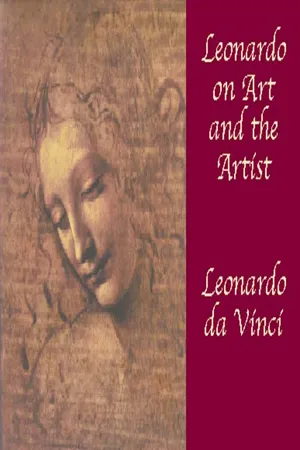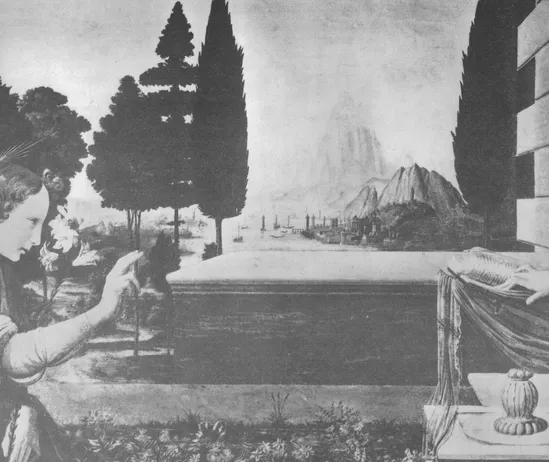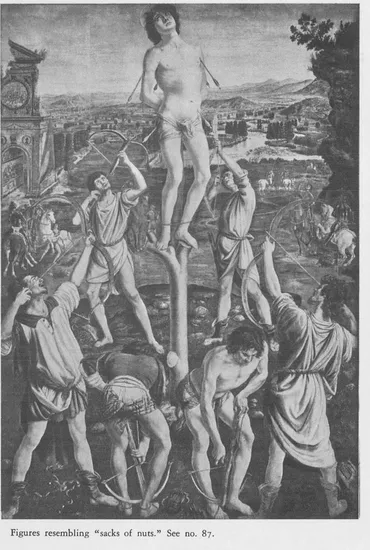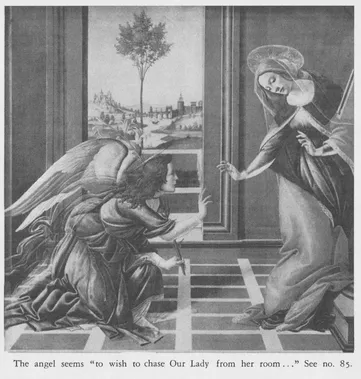
This is a test
- 288 pages
- English
- ePUB (mobile friendly)
- Available on iOS & Android
eBook - ePub
Leonardo on Art and the Artist
Book details
Book preview
Table of contents
Citations
About This Book
Here is a complete picture of the techniques and working philosophy of one of the greatest artistic geniuses of the Renaissance. Assembled by a brilliant scholar from Leonardo's own writings--Notebooks and The Treatise on Painting--as well as his artistic production, the book offers a carefully balanced view of the artist's intellectual growth. Drawing on all the relevant writings, and rectifying many errors made by previous scholars, this work differs from earlier studies in its systematic grouping of the passages of Leonardo's writings concerning painting.
In organizing the materials, the editor focuses on problems of interpretation; the result is the direct opposite of a simple anthology, offering instead a reconstruction of the underlying meaning of Leonardo's words. For each section, noted French art scholar André Chastel has provided an informative introduction and notes, and substantial bibliographic and reference materials for the book as a whole. More than 125 painstakingly reproduced illustrations are found throughout the text, further enhancing this rich and accessible resource, sure to be welcomed by scholars, lay readers, and any admirer of the incomparable Leonardo.
In organizing the materials, the editor focuses on problems of interpretation; the result is the direct opposite of a simple anthology, offering instead a reconstruction of the underlying meaning of Leonardo's words. For each section, noted French art scholar André Chastel has provided an informative introduction and notes, and substantial bibliographic and reference materials for the book as a whole. More than 125 painstakingly reproduced illustrations are found throughout the text, further enhancing this rich and accessible resource, sure to be welcomed by scholars, lay readers, and any admirer of the incomparable Leonardo.
Frequently asked questions
At the moment all of our mobile-responsive ePub books are available to download via the app. Most of our PDFs are also available to download and we're working on making the final remaining ones downloadable now. Learn more here.
Both plans give you full access to the library and all of Perlego’s features. The only differences are the price and subscription period: With the annual plan you’ll save around 30% compared to 12 months on the monthly plan.
We are an online textbook subscription service, where you can get access to an entire online library for less than the price of a single book per month. With over 1 million books across 1000+ topics, we’ve got you covered! Learn more here.
Look out for the read-aloud symbol on your next book to see if you can listen to it. The read-aloud tool reads text aloud for you, highlighting the text as it is being read. You can pause it, speed it up and slow it down. Learn more here.
Yes, you can access Leonardo on Art and the Artist by Leonardo da Vinci in PDF and/or ePUB format, as well as other popular books in Art & Artist Monographs. We have over one million books available in our catalogue for you to explore.
Information
Topic
ArtSubtopic
Artist MonographsThe Problems of the Painter
Leonardo as critic
“ First study science, then follow the practice born of that science ” * is one of Leonardo’s most insistently expressed injunctions. It was as valid for him as for others and was the reason he undertook to write the Treatise on Painting. The discovery of this principle brought about Leonardo’s complete reversal and reconstruction of the order of learning and as a result “ knowledge-experience ” of the visible, that is, painting, was placed at its summit. Naturally, the rules deduced from this principle had to include a detailed discussion of the great gifts of vision ; such discussions are indeed to be found in the notebooks, and the fragments below are meant to give an idea of them.
There is, however, more to what Leonardo called the theory of art than a methodical classification of the solutions to all the problems of the painter. His theoretical works include : 1. A general analysis of the elements of vision and a thorough exploration of its special domains. 2. Notes aiming to formulate and to justify a specific style or organization of the pictorial data. 3. Specific information helpful in the actual practice of painting and study.
Consequently it will be useful to look at Leonardo’s criticism first. He was an extremely severe critic who frequently expressed contempt for facile and superficial works. In these strict judgments and clear insights he usually has someone definite in mind, and, as a rule, it is easy to identify the victims. However, the most interesting aspect of his thesis, here as in his philosophical discussions, is the way in which impersonal, scientific needs are reconciled to an irrational, subjective point of view. In fact, in certain instances a reluctance to draw a conclusion is evident beneath his facility in stating theoretical positions, and in others he postpones making a final statement by thoroughly examining both sides of the question. At times, however, he seems to toss out his conclusions impatiently at his imaginary audience — an opponent who is actually his critical self. As a result, the precepts of the Treatise are backed up by airtight reasoning.
Painting’s fundamental aims are twofold to celebrate the beauty of space modulated by light, and to glorify the characteristic manifestations of life, or, to put it another way, form as the outgrowth of physical reality and as the expression of the vital energy of the universe. Clearly, these two classes do not belong to the same order since one is concerned with “ pure ” observation and the other with psychological perception. The terms “ pure space ” and “pure expression ”are equally important to the creative act. Each is analyzed at length ; the former is discussed in relation to perspective and the dialectics of light and shadow, and the latter in relation to movement and its meaningful expression. Unlike modern artists, Leonardo is not disturbed by the problem that the painter should consider the changes of expression (a smile or frown) first as plastic realities — lines, folds, the play of light — and that this formal interpretation is only possible if emotional content is neglected. Indeed, Leonardo is very willing, even eager, to study expression in terms of plastic realities. However, such a concern would remove emotional content only if the arrangement of pure forms were reduced to a kind of non-expressive geometry. This is not the case. The space is animated, the play of light and shadow on the “ outgrowths of physical realities” is always endowed with emotional content. In short, far from weakening the expressiveness of the human figure, Leonardo extends its force to all of nature.
Since it is rewarding to follow the steps of this development in its subtle changes, this section begins with passages in which Leonardo, while stating his dialectical position, defines, weighs the pros and cons, and selects. Then follow passages showing the two major directions he takes in his attempt to grasp the problems of painting conceived of as the mirror of space and of life. He lends them the greatest exactness and objectivity, either by a mathematical (or pseudo-mathematical) definition of form, or simply by unprecedented clarity of statement ; but at the same time, by means of a significant phrase, metaphor, or exclamation he emphasizes the effect on the sensibilities which, according to him, cannot give rise to any conceptual metaphysics or theology outside of art : the presence of fascinating evidence in the concrete organization of the universe. This is the aim of intellectual art : emotion in terms of objective expression.
Two salient points gradually emerge as Leonardo’s ideas unfold. One is the use of shadow to alter and modulate the light, and it becomes more and more important because of his stress on chiaroscuro. The other is the use of subtle variations of expression to display emotions — such as Mona Lisa’s smile. The first creates an ambiguity in the perception of space, the second in the perception of emotions. The one blurs the neat outlines in the drawing and in place of sharp definition produces an impression of inchoate diffuseness. The latter replaces all lively and obvious gestures with subtle and almost secret motions. As a result, the most interesting effects in his absolute painting are in direct opposition to his statements on the precise and scientific basis of the painter’s craft. The coming together of these special effects mark the moment of beauty. It therefore seems appropriate to follow the sections on Space and Light, and Man and the Emotions with the fragmentary but powerful passages that relate either directly or indirectly to the execution of this superior work.
HOW TO JUDGE PAINTING
These rules are useful only in testing the figures, for all of us make mistakes in the first drafts, and whoever does not know the rules cannot correct them. Hence, knowing your errors, you will correct your works, and wherever you find errors, rectify them and take care not to fall into them again. But if you were to apply all these rules while making your first composition, you would never finish it and would cause confusion in your work.
With the aid of these rules, your judgment is free and sure, because good judgment is born of good understanding, and good understanding is born of reasons elicited from good rules, and good rules are the offspring of good experience, the common mother of all the sciences and all the arts. Therefore, if you remember what my rules prescribe, you will be able, because of your sound judgment, to estimate and recognize all disproportions in the work, whether in the perspective, or in the figures, or in anything else.
Of the judgment that you should make upon a painter’s work. Firstly, you should consider the figures, whether they have the relief required by the location and by the light that strikes them. Shadows should not be the same at the edges of a group as in its center, for it is one thing to be encircled by shadows and another to have the shadows at one side only ....
Secondly, there is the distribution and division of the figures ; this should be made according to the needs of the story you intend to represent.
Thirdly, the figures should be decisive in their action. *
To avoid the reproaches resulting from the different preferences of painters. If you wish to avoid the master painters’ criticisms of all those who do not agree with them on the various points of art, it is necessary to practice the art in several manners in order to conform to some extent with the judgment of each who passes on
The Annunciation. Detail, landscape.


Pollaiuolo, Martyrdom of St. Sebastian.

Botticelli, The Annunciation.
the painter’s work. We shall discuss this diversity later.
Why does one see a painting better in a mirror than without it ? *
How the mirror is the master of painters. To see whether your painting as a whole corresponds to the thing represented, take a mirror and set it so that it reflects the model, and compare this refl...
Table of contents
- DOVER BOOKS ON FINE ART
- Title Page
- Copyright Page
- Table of Contents
- Table of Figures
- Introduction - Leonardo da Vinci and his writings on painting
- Three Biographies of Leonardo
- The Projects
- The Paragone or Comparison of the Arts
- The Universal Program
- The Problems of the Painter
- The Painter’s Studio
- The Painter’s Activity
- Notes
- Printed Editions of Leonardo’s Writings
- Table of Manuscripts
- Table of Paintings
- Chronological Table
- References to Entries